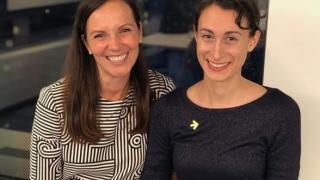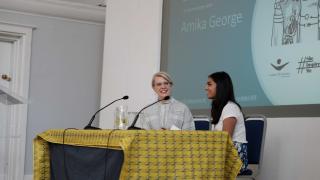5 things we learned at the United Nations Sustainable Development Goals Summit
Last week, Heads of State and Government descended on New York to meet for the Sustainable Development Goals (SDGs) Summit, as part of the 74th session of the United Nations General Assembly.
This was the first UN Summit on the Sustainable Development Goals (also known as the Global Goals) since their adoption in September 2015, and was most certainly a critical milestone ahead of the 5th anniversary of the Goals next year.
Along with members of our Global Advocacy Team, I travelled to New York to represent Women for Women International at the Summit.
Just recently, a report found no country in the world is on track to meet the Goal on gender equality, and another report found that the countries least likely to meet them, are fragile and conflict-affected. It was therefore important for Women for Women International to communicate our message loud and clear: the world is failing the women and girls who live in fragile and conflict-affected countries and only with a concerted effort will we make sure that they are not left behind.
Reflecting on last week’s discussions and debates, here are my 5 key takeaways from the SDG Summit.

1. THERE IS CHRONIC SILO WORKING ACROSS DIFFERENT AGENDAS AND SECTORS
One of the main challenges that impacts on the delivery of the gender equality agenda in fragile and conflict settings is the chronic silo working across the humanitarian, development and peace and security sectors.
For example, in the specific context of the Global Goals, although Goal 5 (on gender equality) includes several targets that are relevant to those under Goal 16 (on peace, justice and strong institutions), experts who work on gender are largely absent from most debates on Goal 16 implementation.
This disconnect is even broader and greater between the Global Goals and other gender-related frameworks and agendas, not least the Women, Peace and Security (WPS) agenda.
While this sounds very abstract, we know from our work in countries like Afghanistan, Nigeria, the DRC, Iraq and South Sudan that the women’s lives and experiences are not dictated by a superficial compartmentalisation of the “humanitarian, development and peace” spheres.
Women and girls in fragile and conflict-affected countries experience a triple burden of extreme poverty, violence and discrimination which is deeply rooted in patriarchal social norms and conservative political systems.
Without concrete action across the three sectors that aim to tackle the root causes of gender inequality, the Global Goals will not be achieved and the most marginalised women and girls will be further marginalised.
Pictured from left to right:
- Marcy Hersh - Senior Manager for Humanitarian Advocacy, Women Deliver
- Aisha Dennis - Programme Director, Women Now for Development
- Brita Fernandez Schmidt - Senior Vice President for Europe and External Affairs, Women for Women International
- Abigail Ruane - Women, Peace and Security Programme Director, Women’s International League for Peace and Freedom
- Nicole Behnam - Senior Director for Violence Prevention & Response, The International Rescue Committee
2. PARTNERSHIPS ARE ABSOLUTELY CRUCIAL
We know this silo working can be overcome if we all work together more effectively to develop a more coordinated, mutually benefiting and coherent approach.
We need to learn from successful examples. We also need to ask difficult questions as to why progress on gender equality and empowerment remains so slow and inadequate. And we need to ask those questions with other stakeholders who work across the humanitarian, development and peace and security sphere.
That’s why I was so pleased to chair our panel event, co-hosted with the UK’s Mission to the United Nations, that focused on the challenge of policy coherence.
It brought together four highly experienced speakers from fantastic partners across the humanitarian, development and peace sectors - the International Rescue Committee (IRC), Women Deliver, the Women’s International League for Peace and Freedom (WILPF), and Women Now for Development.
We discussed tangible actions that policymakers and implementers can take to increase synergies across these different frameworks.
Over the next few weeks, we will be sharing the recommendations that came out of the meeting and we will be using them over the next year, where the global community will be reviewing a series of international commitments spanning across the three sectors.
I am excited that Women for Women International was able to bring together partners in this way and we will continue to do this and shine a light on the importance of working together.
3. THE DATA GAP: HOW MUCH DO WE REALLY KNOW ABOUT THE REALITY FOR WOMEN AND GIRLS LIVING IN CONFLICT AND CRISIS?
Despite governments’ commitment to ‘leave no one behind’, it’s clear that more action is urgently needed to deliver progress for the poorest and most marginalised groups.
However, the extent of the investment needed is unknown. Women and girls in countries facing emergencies and conflict, in particular refugees and internally displaced women, are among the least visible - their reality is often not reflected in the Global Goals progress reports or data collection efforts.
That is why it is so important that alternative forms of data, including from organisations such as ours, are shared and included in analysis to provide a more nuanced picture of our collective progress.
With this in mind, Women for Women International has committed to using the Global Goals as a framework for publishing the data we collect from our programme.
Last week, we launched our annual report cards for the third time. Our intention is to provide a snapshot into the lives of marginalised women survivors of war, highlight our contribution towards the implementation of the Goals and emphasise areas for investment.
You can see the online report cards here.
4. SHIFTING THE BURDEN
One of my most important takeaways from the Global Summit came from Aisha Dennis from Women Now for Development, the largest feminist, women-led civil society organisation operating in Syria.
Aisha spoke so eloquently about how hard it is for an organisation that supports women holistically to find their way through the maze that is the international development, security, humanitarian landscapes.
She talked about how every sector has different objectives and targets which can often actually be at odds with each other, making it nearly impossible for an organisation that works at the crossroads of all three to obtain the support they so urgently need and deserve.
To this point, she asked, “Why is the burden on us - the women at the forefront of these challenging situations?”
This is indeed the question we need to be asking. We must be led by focusing on what women want and need, ensuring it is this which governs the implementation of various policy frameworks - rather than the other way around.
I know that Women for Women International will focus its actions to shift the burden away from the women and onto the international community and its various frameworks.

Why is the burden on us – the women at the forefront of these challenging situations?
5. ACCELERATED AND BOLD ACTION IS URGENTLY NEEDED
The Global Goals recognise that many of the drivers of conflict and crises threaten to reverse much of the development progress made in recent decades.
We know that without increased attention on women and girls in fragile and conflict‐affected contexts, the Global Goals will NOT be achieved.
2020 will be a critical year to reflect on success but also failures to meet and respond to the needs of women in fragile and conflict settings. We need to be bolder.
We need to transform the way we have been working as a so-called “international community”, and to start bringing the system together as a whole. And women - the drivers of development and agents of change in their communities and countries - must lead the way.
Brita Fernandez Schmidt, Senior Vice President for Europe and External Affairs, Women for Women International, discusses why it's important that we work in partnership to ensure that the Global Goals can deliver for marginalised women in conflict-affected countries.
Continue reading
The Global Goals are so incredibly important in helping us to clearly identify the global challenges we face. We can all take one goal that resonates with us, and strive to tackle it in our own way, in our homes, schools, workplaces or communities.
The Global Goals
subtitle:
In 2015, world leaders agreed to 17 Global Goals to end poverty, fight inequality and stop climate change. We are concerned that marginalised women survivors of conflict are being failed by the Goals and are continuing to be left behind.


